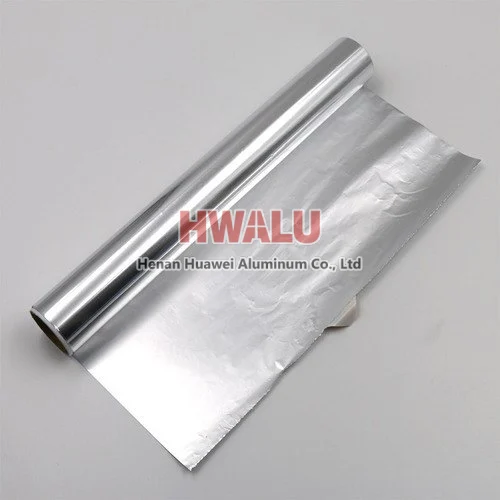why aluminum foil is used to wrap chocolate? How does aluminum foil protect chocolate? We found that both the inside and outside of the chocolate must have the shadow of aluminum foil! One is that chocolate is easy to melt and lose weight, so chocolate needs packaging that can ensure that its weight does not lose, and aluminum foil can effectively ensure that its surface does not melt; The second is the c ...
What is thick aluminum foil Thick aluminum foil refers to a special type of aluminum foil that is thicker than regular aluminum foil. Usually, the thickness of the thick aluminum foil is between 0.2-0.3 mm, which is much thicker than regular aluminum foil. Like conventional aluminium foil, thick aluminum foil also has excellent properties, such as high electrical conductivity, fire prevention, corrosion resis ...
What is aluminum foil for food Aluminum foil for food is a type of aluminum foil that is specifically designed and manufactured for use in food preparation, cooking, storage, and transport. It is commonly used in households and food service industries to wrap, cover, and store food items, as well as to line baking sheets and pans. Aluminum foil for food is available in various sizes, thicknesses, and strength ...
What is 13 micron aluminum foil? "Aluminum Foil 13 Micron" is a thin and light aluminum foil that falls within the thickness range of household aluminum foil and is commonly used for various packaging and insulation purposes. It is a very common thickness specification. 13 micron aluminum foil equivalent name 13μm aluminum foil 0.013mm aluminum foil Household packaging aluminum foil 13 micron aluminum foil ...
what is Pure aluminum foil? Aluminum that is 99% pure or higher is called pure aluminum. Primary aluminium, the metal produced in an electrolysis furnace, contains a series of "impurities". However, in general, only iron and silicon elements exceed 0.01%. For foils larger than 0.030 mm (30µm), the most common aluminum alloy is en aw-1050: pure aluminium foil with at least 99.5% aluminium. (Aluminum larger tha ...
Aluminum foil pinhole has two main factors, one is the material, the other is the processing method. 1. Improper material and chemical composition will lead to a direct impact on the pinhole content of fake aluminum foil Fe and Si. Fe>2.5, Al and Fe intermetallic compounds tend to form coarse. Aluminum foil is prone to pinhole when calendering, Fe and Si will interact to form a firm compound. The number of ...
Aluminum foil has a clean, hygienic and shiny appearance. It can be integrated with many other packaging materials into an integrated packaging material, and the surface printing effect of aluminum foil is better than other materials. In addition, aluminum foil has the following characteristics: (1) The surface of the aluminum foil is extremely clean and hygienic, and no bacteria or microorganisms can grow on ...
Food packaging: Aluminum foil packaging can also be used for food packaging because it is highly malleable: it can easily be converted into flakes and folded, rolled up or wrapped. Aluminum foil completely blocks light and oxygen (resulting in fat oxidation or decay), smell and aroma, moisture and bacteria, and can therefore be widely used in food and pharmaceutical packaging, including long-life packaging (asep ...
Now the aluminum foil we see in the market is no longer made of tin, because it is more expensive and less durable than aluminum. The original tin foil (also known as tin foil) is really made of tin. Tin foil is softer than aluminum foil. It will smell tinted to wrap food. At the same time, tin foil cannot be heated due to its low melting point, or the heating temperature is high-such as 160 It begins to becom ...
In the production of double foil, the rolling of aluminum foil is divided into three processes: rough rolling, intermediate rolling, and finishing rolling. From a technological point of view, it can be roughly divided from the thickness of the rolling exit. The general method is that the exit thickness is greater than Or equal to 0.05mm is rough rolling, the exit thickness is between 0.013 and 0.05 is intermediat ...
As a metal material, aluminum foil is non-toxic, tasteless, has excellent electrical conductivity and light-shielding properties, extremely high moisture resistance, gas barrier properties, and its barrier performance is incomparable and irreplaceable by any other polymer materials and vapor-deposited films. of. Perhaps it is precisely because aluminum foil is a metal material completely different from plastic, i ...






